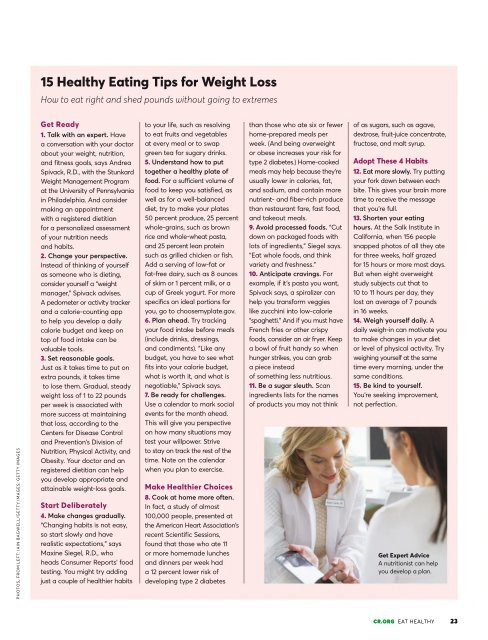Create successful ePaper yourself
Turn your PDF publications into a flip-book with our unique Google optimized e-Paper software.
15 <strong>Healthy</strong> <strong>Eat</strong>ing Tips for Weight Loss<br />
How to eat right <strong>and</strong> shed pounds w<strong>it</strong>hout going to extremes<br />
PHOTOS, FROM LEFT: IAIN BAGWELL/GETTY IMAGES; GETTY IMAGES<br />
Get Ready<br />
1. Talk w<strong>it</strong>h an expert. Have<br />
a conversation w<strong>it</strong>h your doctor<br />
about your weight, nutr<strong>it</strong>ion,<br />
<strong>and</strong> f<strong>it</strong>ness goals, says Andrea<br />
Spivack, R.D., w<strong>it</strong>h the Stunkard<br />
Weight Management Program<br />
at the Univers<strong>it</strong>y of Pennsylvania<br />
in Philadelphia. And consider<br />
making an appointment<br />
w<strong>it</strong>h a registered diet<strong>it</strong>ian<br />
for a personalized assessment<br />
of your nutr<strong>it</strong>ion needs<br />
<strong>and</strong> hab<strong>it</strong>s.<br />
2. Change your perspective.<br />
Instead of thinking of yourself<br />
as someone who is dieting,<br />
consider yourself a “weight<br />
manager,” Spivack advises.<br />
A pedometer or activ<strong>it</strong>y tracker<br />
<strong>and</strong> a calorie-counting app<br />
to help you develop a daily<br />
calorie budget <strong>and</strong> keep on<br />
top of food intake can be<br />
valuable tools.<br />
3. Set reasonable goals.<br />
Just as <strong>it</strong> takes time to put on<br />
extra pounds, <strong>it</strong> takes time<br />
to lose them. Gradual, steady<br />
weight loss of 1 to 22 pounds<br />
per week is associated w<strong>it</strong>h<br />
more success at maintaining<br />
that loss, according to the<br />
Centers for Disease Control<br />
<strong>and</strong> Prevention’s Division of<br />
Nutr<strong>it</strong>ion, Physical Activ<strong>it</strong>y, <strong>and</strong><br />
Obes<strong>it</strong>y. Your doctor <strong>and</strong> an<br />
registered diet<strong>it</strong>ian can help<br />
you develop appropriate <strong>and</strong><br />
attainable weight-loss goals.<br />
Start Deliberately<br />
4. Make changes gradually.<br />
“Changing hab<strong>it</strong>s is not easy,<br />
so start slowly <strong>and</strong> have<br />
realistic expectations,” says<br />
Maxine Siegel, R.D., who<br />
heads <strong>Consumer</strong> <strong>Reports</strong>’ food<br />
testing. You might try adding<br />
just a couple of healthier hab<strong>it</strong>s<br />
to your life, such as resolving<br />
to eat fru<strong>it</strong>s <strong>and</strong> vegetables<br />
at every meal or to swap<br />
green tea for sugary drinks.<br />
5. Underst<strong>and</strong> how to put<br />
together a healthy plate of<br />
food. For a sufficient volume of<br />
food to keep you satisfied, as<br />
well as for a well-balanced<br />
diet, try to make your plates<br />
50 percent produce, 25 percent<br />
whole-grains, such as brown<br />
rice <strong>and</strong> whole-wheat pasta,<br />
<strong>and</strong> 25 percent lean protein<br />
such as grilled chicken or fish.<br />
Add a serving of low-fat or<br />
fat-free dairy, such as 8 ounces<br />
of skim or 1 percent milk, or a<br />
cup of Greek yogurt. For more<br />
specifics on ideal portions for<br />
you, go to choosemyplate.gov.<br />
6. Plan ahead. Try tracking<br />
your food intake before meals<br />
(include drinks, dressings,<br />
<strong>and</strong> condiments). “Like any<br />
budget, you have to see what<br />
f<strong>it</strong>s into your calorie budget,<br />
what is worth <strong>it</strong>, <strong>and</strong> what is<br />
negotiable,” Spivack says.<br />
7. Be ready for challenges.<br />
Use a calendar to mark social<br />
events for the month ahead.<br />
This will give you perspective<br />
on how many s<strong>it</strong>uations may<br />
test your willpower. Strive<br />
to stay on track the rest of the<br />
time. Note on the calendar<br />
when you plan to exercise.<br />
Make Healthier Choices<br />
8. Cook at home more often.<br />
In fact, a study of almost<br />
100,000 people, presented at<br />
the American Heart Association’s<br />
recent Scientific Sessions,<br />
found that those who ate 11<br />
or more homemade lunches<br />
<strong>and</strong> dinners per week had<br />
a 12 percent lower risk of<br />
developing type 2 diabetes<br />
than those who ate six or fewer<br />
home-prepared meals per<br />
week. (And being overweight<br />
or obese increases your risk for<br />
type 2 diabetes.) Home-cooked<br />
meals may help because they’re<br />
usually lower in calories, fat,<br />
<strong>and</strong> sodium, <strong>and</strong> contain more<br />
nutrient- <strong>and</strong> fiber-rich produce<br />
than restaurant fare, fast food,<br />
<strong>and</strong> takeout meals.<br />
9. Avoid processed foods. “Cut<br />
down on packaged foods w<strong>it</strong>h<br />
lots of ingredients,” Siegel says.<br />
“<strong>Eat</strong> whole foods, <strong>and</strong> think<br />
variety <strong>and</strong> freshness.”<br />
10. Anticipate cravings. For<br />
example, if <strong>it</strong>’s pasta you want,<br />
Spivack says, a spiralizer can<br />
help you transform veggies<br />
like zucchini into low-calorie<br />
“spaghetti.” And if you must have<br />
French fries or other crispy<br />
foods, consider an air fryer. Keep<br />
a bowl of fru<strong>it</strong> h<strong>and</strong>y so when<br />
hunger strikes, you can grab<br />
a piece instead<br />
of something less nutr<strong>it</strong>ious.<br />
11. Be a sugar sleuth. Scan<br />
ingredients lists for the names<br />
of products you may not think<br />
of as sugars, such as agave,<br />
dextrose, fru<strong>it</strong>-juice concentrate,<br />
fructose, <strong>and</strong> malt syrup.<br />
Adopt These 4 Hab<strong>it</strong>s<br />
12. <strong>Eat</strong> more slowly. Try putting<br />
your fork down between each<br />
b<strong>it</strong>e. This gives your brain more<br />
time to receive the message<br />
that you’re full.<br />
13. Shorten your eating<br />
hours. At the Salk Inst<strong>it</strong>ute in<br />
California, when 156 people<br />
snapped photos of all they ate<br />
for three weeks, half grazed<br />
for 15 hours or more most days.<br />
But when eight overweight<br />
study subjects cut that to<br />
10 to 11 hours per day, they<br />
lost an average of 7 pounds<br />
in 16 weeks.<br />
14. Weigh yourself daily. A<br />
daily weigh-in can motivate you<br />
to make changes in your diet<br />
or level of physical activ<strong>it</strong>y. Try<br />
weighing yourself at the same<br />
time every morning, under the<br />
same cond<strong>it</strong>ions.<br />
15. Be kind to yourself.<br />
You’re seeking improvement,<br />
not perfection.<br />
Get Expert Advice<br />
A nutr<strong>it</strong>ionist can help<br />
you develop a plan.<br />
CR.ORG EAT HEALTHY 23


















